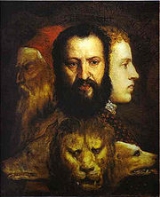
Allegory of Prudence
Encyclopedia
The Allegory of Prudence (c. 1565-1570) is an oil painting
by the Italian master Titian
. It is in the National Gallery, London
.
The picture portrays three human heads, facing different directions, hanging over three animal heads, depicting (from left) a wolf, a lion and a dog. The three human heads represent an allegory
of the "Three Ages of Man" (youth, maturity, old age), like in the famous enigma of the Sphynx
and as later described by Aristotle
.
The humans are thought to be portraits of Titian, his son Orazio, and a young cousin, Marco Vecellio, who, like Orazio, lived and worked with Titian. Titian also painted a late self-portrait
in 1567, from which the comparison is made. The other faces also occur in other Titian paintings of the period.
It is the only painting by Titian to contain a motto
: EX PRAETERITO/PRAESENS PRUDENTER AGIT/NE FUTURA ACTIONẼ DETURPET ("From [the experience of] the past, the present acts prudently, lest it spoil future actions").
The painting is connected by Erwin Panofsky
, in a famous exposition, with Titian's success in 1569 in transferring his senseria, a valuable "broker's patent" granted him by the Signoria
, to his son. Titian is therefore the past, Orazio the present, and in the absence of a grandson, Marco is the future.
Oil painting
Oil painting is the process of painting with pigments that are bound with a medium of drying oil—especially in early modern Europe, linseed oil. Often an oil such as linseed was boiled with a resin such as pine resin or even frankincense; these were called 'varnishes' and were prized for their body...
by the Italian master Titian
Titian
Tiziano Vecelli or Tiziano Vecellio Tiziano Vecelli or Tiziano Vecellio Tiziano Vecelli or Tiziano Vecellio (c. 1488/1490 – 27 August 1576 better known as Titian was an Italian painter, the most important member of the 16th-century Venetian school. He was born in Pieve di Cadore, near...
. It is in the National Gallery, London
National Gallery, London
The National Gallery is an art museum on Trafalgar Square, London, United Kingdom. Founded in 1824, it houses a collection of over 2,300 paintings dating from the mid-13th century to 1900. The gallery is an exempt charity, and a non-departmental public body of the Department for Culture, Media...
.
The picture portrays three human heads, facing different directions, hanging over three animal heads, depicting (from left) a wolf, a lion and a dog. The three human heads represent an allegory
Allegory
Allegory is a demonstrative form of representation explaining meaning other than the words that are spoken. Allegory communicates its message by means of symbolic figures, actions or symbolic representation...
of the "Three Ages of Man" (youth, maturity, old age), like in the famous enigma of the Sphynx
Sphinx
A sphinx is a mythical creature with a lion's body and a human head or a cat head.The sphinx, in Greek tradition, has the haunches of a lion, the wings of a great bird, and the face of a woman. She is mythicised as treacherous and merciless...
and as later described by Aristotle
Aristotle
Aristotle was a Greek philosopher and polymath, a student of Plato and teacher of Alexander the Great. His writings cover many subjects, including physics, metaphysics, poetry, theater, music, logic, rhetoric, linguistics, politics, government, ethics, biology, and zoology...
.
The humans are thought to be portraits of Titian, his son Orazio, and a young cousin, Marco Vecellio, who, like Orazio, lived and worked with Titian. Titian also painted a late self-portrait
Self-portrait
A self-portrait is a representation of an artist, drawn, painted, photographed, or sculpted by the artist. Although self-portraits have been made by artists since the earliest times, it is not until the Early Renaissance in the mid 15th century that artists can be frequently identified depicting...
in 1567, from which the comparison is made. The other faces also occur in other Titian paintings of the period.
It is the only painting by Titian to contain a motto
Motto
A motto is a phrase meant to formally summarize the general motivation or intention of a social group or organization. A motto may be in any language, but Latin is the most used. The local language is usual in the mottoes of governments...
: EX PRAETERITO/PRAESENS PRUDENTER AGIT/NE FUTURA ACTIONẼ DETURPET ("From [the experience of] the past, the present acts prudently, lest it spoil future actions").
The painting is connected by Erwin Panofsky
Erwin Panofsky
Erwin Panofsky was a German art historian, whose academic career was pursued mostly in the U.S. after the rise of the Nazi regime. Panofsky's work remains highly influential in the modern academic study of iconography...
, in a famous exposition, with Titian's success in 1569 in transferring his senseria, a valuable "broker's patent" granted him by the Signoria
Signoria
A Signoria was an abstract noun meaning 'government; governing authority; de facto sovereignty; lordship in many of the Italian city states during the medieval and renaissance periods....
, to his son. Titian is therefore the past, Orazio the present, and in the absence of a grandson, Marco is the future.

